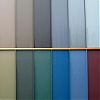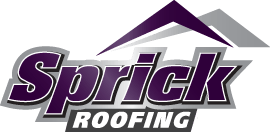Low Slope (3/12 or less)
Single-ply Roof Membranes (PVC & TPO)
Single-ply roof systems are field applied systems where the main covering is just one layer of membrane material rather than multiple layers. PVC (polyvinyl chloride) and TPO (thermoplastic polyolefin) are two common single-ply membranes. PVC and TPO come in thicknesses ranging from 40 to 80 mils and can be either mechanically fastened or fully adhered to the roof deck with the seams heat welded together. Both materials are favored for being light-weight, highly reflective and easy to repair.
Green  Material Links:
Material Links:
Built Up Roofing (BUR)
Built up roof membranes – commonly referred to by the acronym BUR – have been used in the U.S. for over 100 years. These roof systems are commonly referred to as “hot asphalt” or “tar and gravel” roofs. BUR systems are continuous, semi-flexible roof membranes, consisting of multiple layers of saturated felts, coated felts, fabrics or mats assembled in place with alternate plies (or layers) of bitumen (hot asphalt, coal tar or a cold applied adhesive) and surfaced with either mineral aggregate (gravel or cinder), a liquid-applied coating or a granule-surfaced cap sheet, the purpose of which is to protect the final layer of asphalt from prematurely drying out from the sun’s rays. The number of plies in a cross section is the number of plies on a roof; the term “four plies” denotes the number of layers in the membrane construction. The base ply covers the substrate and is either mechanically fastened or fully adhered. The ply sheets are the multiple layers of felt sandwiched together by the hot asphalt, and the surfacing ply is the top layer that protects the BUR.
Green  Material Links:
Material Links:
Metal
Metal is quickly gaining popularity as a roofing material option. It is durable, long-lasting, relatively maintenance-free, energy efficient, nonflammable and recyclable. Metal roof panels may be made of galvanized steel with a baked on enamel paint finish, all copper, or corrosion resistant alloys such as Zincalume® or Galvalume®. Although once limited to use on low-slope structures, metal can now also be used on steep-sloped roof systems. Installed in either vertical or horizontal panels, a metal roof will actually dissipate a lightning strike rather than conduct it – an old myth and concern.
Click on an image to enlarge the photo:




